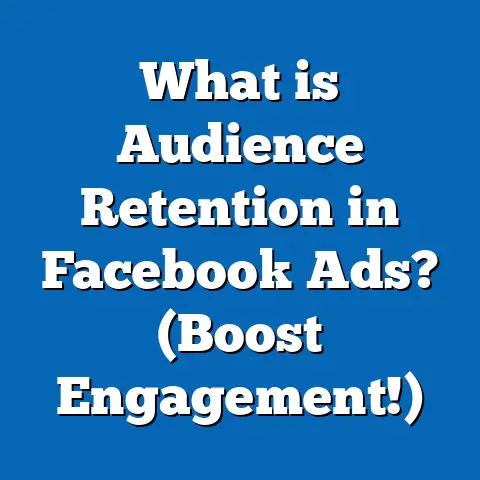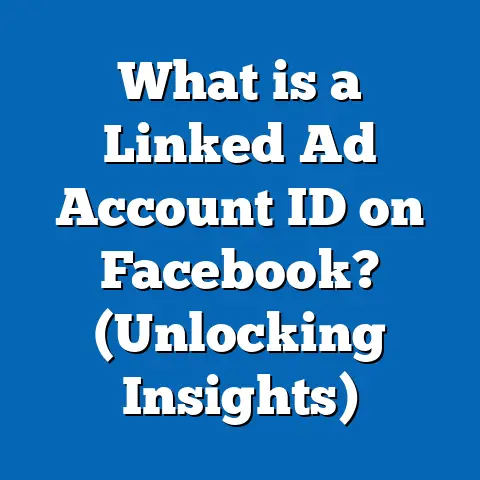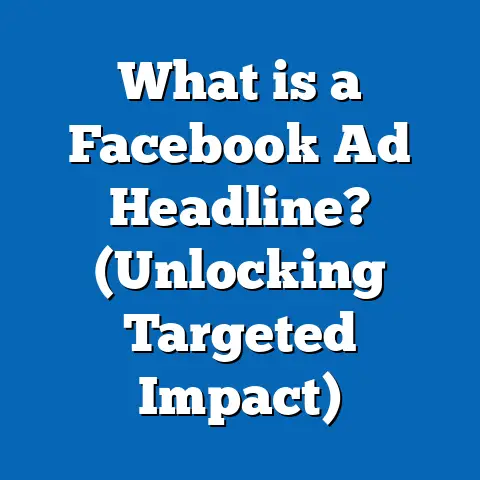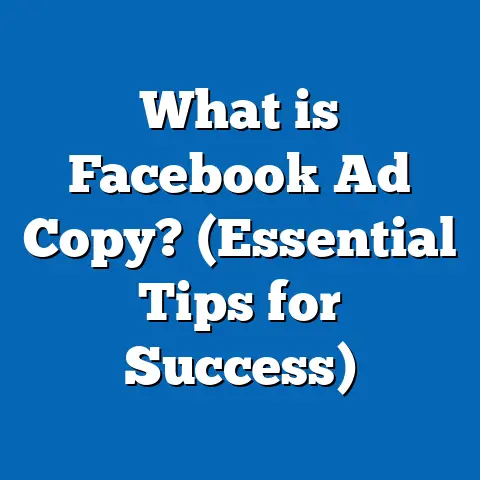What is Facebook Ad Credit? (Unlocking Advertising Potential)
What is Facebook Ad Credit? (Unlocking Advertising Potential)
Introduction: The Emotional Power Behind Every Click
Imagine the thrill of launching a new product or service and the anxiety that comes with every dollar spent on marketing. For many business owners and marketers, that tension between ambition and budget constraints is real. Facebook Ad Credit offers a unique opportunity to bridge this gap—allowing advertisers to explore powerful marketing strategies without the immediate fear of financial loss. It’s more than just a discount; it’s a key that unlocks the door to digital advertising potential on one of the world’s largest platforms. This opportunity can turn hesitation into action, dreams into measurable results.
Understanding Facebook Ad Credit: Basics and Beyond
What Is Facebook Ad Credit?
Facebook Ad Credit is a promotional balance provided by Facebook to advertisers, allowing them to run advertisements on the platform without upfront charges deducted from their own funds. Think of it as a prepaid advertising budget offered either as a welcome gift, promotional incentive, or compensation in specific circumstances.
- Definition: A virtual coupon or credit balance applied to your Facebook Ads account.
- Purpose: To encourage advertisers, especially new or small businesses, to engage with Facebook Ads.
- Value Range: Credits often vary from $25 to $150 or more depending on the promotion or campaign.
- Application: Automatically deducted from ad spend before charging your payment method.
Who Is Eligible for Facebook Ad Credit?
Eligibility varies but typically includes:
- New advertisers creating their first campaigns.
- Businesses affected by specific global events (e.g., COVID-19 recovery support).
- Participants in Facebook marketing programs or workshops.
- Advertisers invited via promotional emails or partnership deals.
Why Does Facebook Offer Ad Credits?
Facebook’s business model thrives on advertisers’ spend. Ad credits serve as an entry point to attract new advertisers and keep existing ones engaged.
Key reasons include:
- Reducing barriers for new businesses hesitant to invest heavily upfront.
- Encouraging experimentation with different ad formats and targeting.
- Building advertiser trust and loyalty over time.
- Driving long-term revenue growth through increased ad spend.
Historical Context
Facebook has been offering ad credits since its early days to stimulate advertiser growth. As the platform matured, credits evolved from simple “welcome” offers to more strategic tools aligned with business goals and platform updates.
How Facebook Ad Credit Works in Practice
Activation and Application Process
Facebook ad credits can be applied in several ways:
- Automatic Application: After meeting certain criteria (new account, first campaign), credits are automatically added.
- Promo Codes: Advertisers receive codes through email or promotions that must be entered manually in the billing section.
- Compensation Credits: In cases of billing errors or service disruptions, Facebook may issue ad credits as refunds.
Utilizing Credits During Campaign Setup
When you launch a campaign:
- Facebook first deducts ad spend from your credit balance.
- Once credits are exhausted, charges begin on the linked payment method.
- You can monitor credit usage in Ads Manager under the billing tab.
Common Restrictions and Conditions
- Credits expire (usually 30–90 days).
- Cannot be cashed out or transferred between accounts.
- May exclude some ad types or placements (e.g., certain dynamic ads).
- Typically limited to one use per advertiser or account.
Deep Dive: The Mechanics of Facebook Advertising Costs and Credits
How Facebook Charges for Ads
Facebook uses an auction system where advertisers bid for ad placements. Costs depend on:
- Objective: Clicks, impressions, conversions.
- Target Audience: Size, competition.
- Ad Quality and Relevance: Better-performing ads cost less per result.
- Bidding Strategy: Manual vs automatic bidding.
Ad credits cover these costs until exhausted.
Example Calculation
Suppose you receive a $100 ad credit. Your ad campaign costs $10 per day.
| Day | Daily Spend | Remaining Credit |
|---|---|---|
| 1 | $10 | $90 |
| 2 | $10 | $80 |
| … | … | … |
| 10 | $10 | $0 |
After day 10, any spend would be charged to your payment method.
Billing Cycle and Invoice Handling
- Facebook bills monthly or when you hit a billing threshold.
- Credits reduce your billed amount.
- You receive invoices reflecting the use of credits and remaining balances.
Data Insights: The Impact of Facebook Ad Credit on Advertising Outcomes
Statistical Overview and Industry Research
Research shows that ad credits significantly influence advertiser behavior:
- Adoption Rate: According to Facebook’s 2023 internal data, 40% of new advertisers who received credits launched at least two campaigns within three months.
- Return On Ad Spend (ROAS): Average ROAS improved by 18% among advertisers who utilized credits for initial testing phases.
- Small Business Growth: A survey by Social Media Examiner indicated that 62% of SMBs used ad credits to experiment with audience targeting before committing larger budgets.
Broader Market Trends
The adoption of digital ads is growing rapidly. eMarketer forecasts that in 2025, global digital ad spend will reach $720 billion, with social media accounting for nearly 30%. Facebook remains a dominant player with over 2 billion active users monthly, making its ad credits especially valuable for businesses seeking broad reach.
Case Studies: Real Businesses Leveraging Facebook Ad Credit for Growth
Case Study 1: FreshBite – A Health Food Startup
Background: FreshBite struggled with limited marketing funds during its launch phase.
Strategy: Used a $100 Facebook Ad Credit focusing on highly targeted video ads aimed at health-conscious millennials in urban areas.
Execution Details:
- Created three different video creatives testing various messages.
- Targeted based on interests such as organic food and fitness.
- Monitored engagement metrics daily.
Results:
- Reached over 50,000 people within two weeks.
- Website traffic increased by 25%.
- Email sign-ups rose by 15%.
Aftermath: Confidence gained from initial success led to investing $500 monthly in sustained campaigns, scaling sales by 200% over six months.
Case Study 2: TechFix – Local Electronics Repair Shop
Background: TechFix wanted to boost local brand awareness but had no prior digital marketing experience.
Strategy: Received $75 Facebook Ad Credit after attending a free workshop hosted by Facebook.
Execution:
- Ran carousel ads showcasing repair services and customer testimonials.
- Targeted within a 10-mile radius around the store.
- Utilized call-to-action buttons for booking appointments online.
Outcomes:
- Generated 120 appointment bookings in one month.
- Increased walk-in traffic by 18%.
- Converted 35% of online leads into paying customers.
Case Study 3: EcoWear – Sustainable Fashion Brand
Background: EcoWear aimed to test different demographics across regions before expanding campaigns internationally.
Strategy: Applied promotional credit to run split tests comparing performance between age groups and locations.
Results:
- Identified high-value segments generating cost-per-acquisition (CPA) 30% lower than average.
- Reduced wasted budget on low-performing audiences.
- Improved overall campaign efficiency by 22%.
Technical Breakdown: Integrating Facebook Ad Credit into Your Advertising Budget
Budget Planning with Ad Credits
Ad credits should be viewed as a launchpad rather than a full budget replacement.
Steps to integrate:
- Set Clear Objectives: Define what success looks like (e.g., clicks, conversions).
- Estimate Cost per Result: Use industry benchmarks or historical data if available.
- Allocate Credits for Testing: Use credits primarily for experimentation and data gathering.
- Plan Paid Budget Post-Credit: Prepare to fund campaigns after credits expire for continuity.
Using Ads Manager Tools Effectively
Facebook Ads Manager provides tools to track credit usage:
- Billing dashboard shows remaining credit balance.
- Campaign reports display spend against credit limits.
- Alerts notify you when approaching credit exhaustion.
Monitoring Metrics During Credit Use
Key metrics to watch include:
- Click-through rate (CTR)
- Cost per click (CPC)
- Conversion rate
- Frequency (to avoid overexposure)
These metrics help optimize campaigns within the credit period.
Advanced Strategies for Maximizing Your Facebook Ad Credit
Strategy 1: A/B Testing Without Financial Risk
Use your ad credit to test:
- Headlines
- Images or videos
- Call-to-action buttons
- Target audiences
Example: Run two variations of an ad with different images for the same budget and compare results. Use insights to scale winning ads post-credit period.
Strategy 2: Audience Expansion Using Lookalike Audiences
Leverage credits to create lookalike audiences based on your best customers:
- Upload customer lists or pixel data.
- Create lookalikes targeting users similar to your existing customers.
- Test these audiences with credit-funded campaigns before full rollout.
Strategy 3: Retargeting Warm Leads Cost-Efficiently
Use ad credit to retarget website visitors or engagement audiences:
- Set up Facebook Pixel on your website.
- Create custom audiences of visitors who didn’t convert.
- Use ads tailored to push these users down the sales funnel.
How Facebook Ad Credit Compares With Other Platforms’ Incentives
| Platform | Typical Credit Offerings | Use Case Focus | Unique Features |
|---|---|---|---|
| $25–$150 promotional credits | Broad audience targeting; SMB focus | Wide array of ad formats; strong analytics | |
| Google Ads | $100–$150 credits for new users | Search intent-based marketing | Keyword targeting; intent-driven ads |
| LinkedIn Ads | Smaller credits ($50 max typical) | B2B lead generation | Professional audience; expensive CPM |
| Twitter Ads | Smaller, campaign-specific credits | Brand awareness & engagement | Real-time engagement; trending topics focus |
Why Choose Facebook?
Facebook’s unmatched user base combined with flexible credit opportunities makes it ideal for businesses looking for:
- Diverse ad formats (video, carousel, stories).
- Granular audience targeting options.
- Integration with Instagram and Messenger ads.
Practical Tips and Common Pitfalls When Using Facebook Ad Credit
Best Practices
- Understand Terms Thoroughly: Know expiration dates and eligible ad types upfront.
- Start Small: Use credits strategically rather than spreading thin across many campaigns.
- Focus on Data Collection: Use credit-funded campaigns primarily to collect insights about audience behavior and creative effectiveness.
- Combine Paid and Organic Efforts: Boost organic content with paid ads using credits for amplified reach.
Pitfalls to Avoid
- Relying solely on credits without a plan for sustainable paid advertising.
- Ignoring performance data during your credit usage period.
- Running overly broad campaigns that dilute results and waste precious credits.
- Failing to set clear goals before spending credits.
Staying Current: Trends and Updates in Facebook Advertising Credits (2024–2025)
Changes in Promotional Strategies
Facebook has refined its ad credit offerings:
- More personalized offers based on advertiser history and business category.
- Integration with AI-powered tools for automated optimization during credit campaigns.
- Increased support for SMBs post-pandemic with focused recovery grants in advertising.
Emerging Features Impacting Ad Credit Use
Facebook continues enhancing:
- Enhanced audience insights via AI-driven analytics tools.
- New ad formats like immersive AR experiences requiring creative testing budgets—credits facilitate experimentation here.
- Automated rules that can pause campaigns once credit limits are reached, preventing overspending.
Summary and Next Steps for Marketers and Business Owners
Key Takeaways
- Facebook Ad Credit lowers entry barriers into digital advertising by reducing upfront costs.
- It encourages new advertisers to experiment without financial risk while increasing platform engagement.
- Data shows users of ad credits achieve better ROI and higher adoption rates long-term.
- Strategic planning is essential—use credits primarily for testing before scaling paid budgets.
Actionable Next Steps
- Verify eligibility for ad credits via Facebook Ads Manager or official communications.
- Develop a clear campaign objective aligned with available credit funds.
- Launch small-scale tests focusing on audience targeting and creative messaging using these credits.
- Analyze performance closely; adapt messaging based on results gathered during credit use.
- Prepare budget plans for post-credit campaigns leveraging insights gained.
- Stay updated on new Facebook promotional offers and platform innovations regularly.
Appendix A: Glossary of Key Terms Related to Facebook Ad Credit
| Term | Definition |
|---|---|
| Ad Credit | Promotional balance applied to offset advertising costs |
| Return On Ad Spend (ROAS) | Revenue generated per dollar spent on ads |
| Cost Per Acquisition (CPA) | Cost incurred to achieve one conversion |
| Lookalike Audience | An audience similar in profile to your existing customers |
| Facebook Pixel | Tracking code installed on websites to measure ad impact |
| Billing Threshold | The spend amount triggering billing charges |
Appendix B: Additional Resources for Learning About Facebook Advertising
- Facebook Business Help Center
- Facebook Blueprint Certification Courses
- Social Media Examiner – Facebook Ads Guide
- eMarketer Reports on Social Media Advertising






